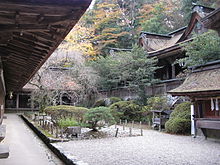Mikumari Shrine (Yoshino)
Coordinates: 34 ° 21 '14.2 " N , 135 ° 52' 23.4" E

The Mikumari Shrine ( Japanese 水分 神社 , Mikumari-jinja ) is a Shinto shrine in Yoshino ( Nara Prefecture , Japan ) It is one of four Mikumari shrines in the former province of Yamato , in which the female deity Mikumari has been from ancient times is venerated, which is why it is also called the Yoshino Mikumari Shrine ( 吉野 水分 神社 ) to distinguish it. Since 2004 it has been part of the UNESCO World Heritage Site Sacred Sites and Pilgrimage Routes in the Kii Mountain Range .
architecture
The structure around an inner courtyard shows a prayer hall ( haiden , 拝 殿 ) on the left after entering through the gate building ( rōmon , 楼門 ). On the side opposite the gate is the sacrificial hall ( heiden , 幣 殿 ). The main hall ( honden , 本 殿 ) on the right is built in a combination of Kasuga style ( kasugazukuri , 春日 造 ) and flowing style ( nagarezukuri , 流 造 ) and shows three small shrines for the main deity (center) and various secondary deities ( right left).
history
The exact age is not known; The history of the shrine probably goes back to the year 806. The oldest written reference can be found in the Shoku Nihongi chronicle in the second year of the reign of Tennō Mommu (= 698 AD). The plant was originally located in the rear of the Yoshino massif on the summit of the Aonega mine. Since three tributaries of the Yoshino River (Yoshinogawa) arise on the north, east and west side of this mountain, the idea arose that the deity distributes water ( mizu , water; kubari , distribution). In 806 the facility was moved to its current location (Yoshino Kami-Senbon).
Since about the middle of the Heian period , Mikumari has also been considered a protective deity for children ( Komori myōjin or Mikomori myōjin 御 子 守 明 神 ). The current complex was built in 1605 by Toyotomi Hideyori , whose father Toyotomi Hideyoshi , according to tradition, prayed for a son here and was heard.
In the course of the mixing of Buddhism and Shinto , the main deity was assigned as Komori gongen ( 子 守 権 現 ) to the Kimpusen Temple, only a few kilometers away . Until the separation of the two religions ( Shinbutsu-bunri ) in the course of the Meiji Restoration , retreats for the followers of the syncretistic Shugendo took place here.
The shrine is mentioned in the famous pillow book ( Makura no sōshi ) of the lady-in-waiting Sei Shōnagon and the diary of the lady-in-waiting and writer Murasaki Shikibu ( Murasaki Shikibu nikki ), and the influential philologist Motoori Norinaga (1730-1801) explains in the journal of his trip to Yoshino ( Sugagasa no nikki ) that his father prayed here.
Deities
The main deity residing in the central part of the main hall is Ame-no-mikumari-no-ōkami ( 天 之 水分 大 神 ), who distributes the water of heaven, ensures fertility for women and safe births. The secondary deities are Takami-musubi-no-kami ( 高 皇 産 霊 神 ), Sukuna-hiko-no-kami ( 少 名 彦 神 ), Mikogami ( 御 子 神 ), Ama-tsu-hiko-hi-no- ninigi-no-mikoto ( 天津 彦 火 瓊瓊 杵 命 ), Tama-yori-hime-no-mikoto ( 玉 依 姫 命 ) and Yorozu-hata-toyo-akitsushi-hime-no-mikoto ( 天 萬 栲 幡 千 幡 比咩 命 ) venerated.
A wooden statue of the deity Tamayori-hime (Princess Tamayori) created in the Kamakura period is registered as a national treasure .
literature
- Norman Havens, Nobutaka Inoue: An Encyclopedia of Shinto . Institute for Japanese Culture and Classics Kokugakuin University, 2001-2006.
- Restoration report of the Nara Prefectural Property Preservation Bureau, 1976 ( 奈良 県 文化 財 保存 事務所 『重要 文化 財 吉野 水分 神社 拝 拝 殿 幣 殿 修理工 事 報告 書』 奈良 、 1976 )




